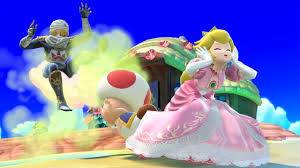Discussion Question:
Should Smash Bros change female characters to better support feminist goals, or should they prioritize staying true to the original characters (many of whom were designed in the past with more traditional, and sometimes insensitive stereotypes)?
Today I’ll be looking at one of my favorite games of all time: Super Smash Bros. Currently SSB Ultimate is a huge hit on the fighting game scene. With a roster of 89 characters, including 26 female fighters, I figured it’s a great game to explore how feminist goals have merged into modern. Let’s dive into how Smash Bros. handles feminist perspectives and where it could do better.
First, I’ll acknowledge that Super Smash Bros. Ultimate definitely lets female characters shine. In a genre normally dominated by male characters, Smash not only provides a solid range of female characters, but also provides them with a lot of power and versatility in terms of combat. Characters like Samus and Zelda are strong and capable, fitting Chess’s idea that female characters should have deep, meaningful stories. Samus, for instance, is a powerful bounty hunter whose abilities define her more than her gender. These characters also stay true to themselves without being forced into aggressive or sexualized roles. For example, Peach remains a princess, Zelda and Sheik are warriors, and Isabelle keeps her gentle demeanor from Animal Crossing. This aligns with Chess’s call for authentic and powerful female characters.
This has its drawbacks though, and I will say, the game also clings to some gender stereotypes and misses chances to fully embrace feminist ideas. For example, Princess Peach and Daisy, which are Nintendo’s usual “damsel in distress” characters, get a chance to change that as fighters in Smash. But sadly the chance is never realized, since all of their moves/design revolve around traditional femininity stereotypes (such as Peach’s side special, which is a glorified “booty bump” and Peach’s down special where she gardens and picks out a turnip). Also when the game was released, Zero Suit Samus faced criticism for her revealing outfit, since many argued her design was more for the male gaze than practical for battle.
To be fair, I see where Nintendo struggles with female representation in Smash Bros, since the game relies on famous characters from other franchises, often perpetuating traditional gender roles. Princess characters like Peach and Daisy are stereotypical, and Samus’s ambiguous look under her suit might not add much diversity among female characters. However, I also will argue that other famous characters like Sonic for instance have many moves that aren’t really similar to old Sonic games, so I argue that Nintendo could have changed up Peach and Daisy as well.
Still though, Smash Bros. has great potential for feminist progress. Recent additions like Joker from Persona 5 and Alex from Minecraft show the game can include diverse and unexpected characters. This trend opens the door for more varied female characters, aligning with feminist values of diversity and equality. Future additions could really boost the game’s feminist credentials.
Besides the characters, the gameplay in Smash Bros. matches some points in Chess’s chapter on Gaming Feminism. While the game has a story mode, most players, including me and my roommates, stick to battle mode. This focus on battle mode fits Chess’s idea of the “narrative middle,” where the experience is about ongoing engagement, not a big story climax. Winning a match feels great, but that excitement quickly fades as the next match starts, highlighting the arcade-style structure.
But the game still follows some genre conventions that Chess critiques. The focus on combat draws a more masculine audience, and the lack of deep stories for many characters limits meaningful feminist storytelling. Chess argues that games should challenge traditional gender roles, and while Smash Bros. makes some progress, it often sticks to familiar tropes.
To better align with feminist ideas, Smash Bros. could add more nuanced character development and diverse representations of femininity. Adding story modes or background lore that explore characters’ motivations and histories could add depth. Redesigning some characters to avoid sexualization and focus on their combat skills and personalities would also help fight gender stereotypes.




